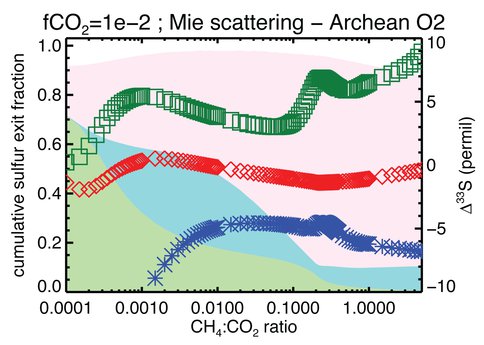2011 Annual Science Report
 VPL at University of Washington
Reporting | SEP 2010 – AUG 2011
VPL at University of Washington
Reporting | SEP 2010 – AUG 2011
Postdoctoral Fellow Report: Mark Claire
Project Summary
I have studied how biology might have impacted Earth’s early atmosphere, and how the Sun’s light has changed with time. More specifically, I’ve modeled how enhanced release of biogenic sulfur gases in earlier periods of Earth history may have left clues in the geologic record, and compared these predictions to the data. Furthermore, I have made a model of what how the light from the Sun would appear at any planet or any time in the solar system.
Project Progress
This document reports on activities during year 1.5 through 2.5 of my NAI/NPP postdoctoral fellowship. I undertook significant model development and published an article on the astronomical detection of biogenic sulfur gases in Astrobiology (Domagal-Goldman et al., 2011). The above project addressed the “biosignatures” part of my NPP proposal, so I turned to the “biospheres” component and continued to build a case that biogenic sulfur metabolism played a vital role during the great oxidation event. We are actively exploring how biogenic sulfur gases may have affected the climate and chemistry of the late Archean and early Proterozoic (Claire and Kasting, 2010)
I enhanced the sulfur isotope photochemical model developed during the last period of performance to include higher order hydrocarbon species (e.g. Domagal-Goldman, 2008) and the newly discovered fractal scattering properties of organic haze particles (Wolf and Toon, 2010). We are investigating claims of self-shielding by SO2 (Lyons, 2009), shielding by (potentially biogenic) OCS (Ueno et al. 2009), and CO2 (Halevy et al. 2010). At AGU, I argued that these other works use oversimplified versions of atmospheric chemistry that are not sufficient to resolve the complexities of the Archean rock record (Claire and Kasting, 2010) and am nearing completion on a manuscript which suggests a novel interpretation of Earth’s sulfur isotope record.
Substantial effort has been directed toward understanding the linkages between the carbon and sulfur cycles on the Archean Earth. Working with international collaborators and exciting new data from an ancient carbonate platform, team members Claire and Domagal- Goldman have postulated a linkage between periods of enhanced methane production and changes in the atmospheric sulfur cycle observable in the geologic record. This work provides crucial evidence that the Earth may have been enshrouded in a Titan-like organic haze at certain time periods in the Archean. Furthermore, our recent work supports the argument that a thick haze is infeasible and that the Earth system may oscillate between two bi-stable states: thin-haze and clear skies (Zerkle et al, 2011)
Finally, during this period of performance, I completed my numerical model for the early Solar flux and its associated uncertainties (submitted for publication). Working with VPLinvestigators Martin Cohen, David Catling, John Sheets, and Vikki Meadows, I extended the results of Ribas et al. 2005 into the near UV, and have made quantitative predictions of the solar flux applicable to any place and time in the solar system.
This figure shows results from photochemical model of the late Archean atmosphere run at increasing amounts of biogenic methane (from left to right on x-axis CH4 concentrations from 1ppm to 5% at a fixed CO2 concentration of 1%) At CH4:CO2 ratios greater than 0.1, an organic haze forms in the model atmospheres. The shaded regions show the fraction of the total sulfur input that leaves the atmopshere as sulfate (light green), elemental sulfur (light blue) and SO2 (light red). These are mapped to the left y-axis (e.g. at CH4:CO2 = 0.01, approximately 20% of S exits as sulfate, 30% exits as elemental sulfur, and 45% exits as SO2). The symbols map to the right y-axis and are the predicted S-MIF present in the exit channels (dark green = sulfate, dark blue = elemental sulfur, dark red = SO2)
Publications
-
Domagal-Goldman, S. D., Meadows, V. S., Claire, M. W., & Kasting, J. F. (2011). Using Biogenic Sulfur Gases as Remotely Detectable Biosignatures on Anoxic Planets. Astrobiology, 11(5), 419–441. doi:10.1089/ast.2010.0509
- Claire, M. & Kasting, J.F. (2010). Variations in the magnitude of non mass dependent sulfur fractionation in the Archean atmosphere. AGU Fall Meeting Abstracts, 14: 03.
- Halevy, I., Johnston, D.T. & Schrag, D.P. (2010). Constraints on the Archean Surface Environment from Mass-Independent Sulfur Isotopes (Invited). AGU Fall Meeting Abstracts, 14: 02.
- Wolf, E.T. & Toon, O.B. (2010). a Fractal Aggregate Model of Early Earth Organic Hazes: UV Shielding with Minimal Antigreenhouse Cooling. AGU Fall Meeting Abstracts, 11: 1317.
-
PROJECT INVESTIGATORS:
-
PROJECT MEMBERS:
David Catling
Co-Investigator
Martin Cohen
Co-Investigator
James Kasting
Co-Investigator
Victoria Meadows
Co-Investigator
Kevin Zahnle
Co-Investigator
Shawn Domagal-Goldman
Postdoc
-
RELATED OBJECTIVES:
Objective 1.1
Formation and evolution of habitable planets.
Objective 1.2
Indirect and direct astronomical observations of extrasolar habitable planets.
Objective 2.1
Mars exploration.
Objective 4.1
Earth's early biosphere.
Objective 7.2
Biosignatures to be sought in nearby planetary systems

